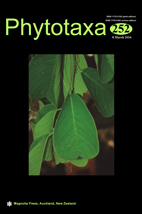Abstract
Myrioneuron R. Brown ex J. D. Hooker in Bentham & Hooker (1873: 69) comprises about eight species of the family Rubiaceae and it is distributed in East Himalaya to South China (Govaerts et al. 2011). Although it was occasionally treated as a synonym of Mycetia Reinwardt (1825: 9) (Bakhuizen 1975) or Keenania J. D. Hooker (1880: 101) (Van Steenis 1987, Robbrecht 1988), most botanists accepted it as a distinct genus (Kurz 1877, Hooker 1880, Schumann 1891, Pitard 1923, Merrill 1942, Bremekamp 1952, Deb 1996, Lo 1999, Wright 1999, Kress et al. 2003; Chen & Taylor 2011, Govaerts et al. 2011). Most recently, however, a molecular phylogenetic study revealed that Myrioneuron and Mycetia are non-monophyletic and intermixed, and therefore both taxa were combined to represent a monophyletic genus and Mycetia was accepted as its generic name (Ginter et al. 2015). In the study, they published nine new combinations, including Mycetia angustifolia (J. D. Hooker 1880: 97) Razafim. & B. Bremer in Ginter et al. (2015: 293). However, this name is illegitimate because it is a later homonym of Mycetia angustifolia Ridley (1923: 68), in accordance with Article 53.1 of the ICN (McNeil et al. 2012).

